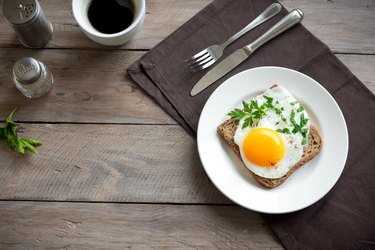
When trying to lose weight, you need a diet plan where you consume fewer calories than you burn. Every demographic has a different target caloric intake to maintain their body weight, depending on their age, gender and activity levels. So, it's essential to tailor your diet to your specific needs.
Tip
A 1,200 calorie a day diet should be broken into three 300 calorie meals and three 100 calorie snacks. So, your breakfast should aim to be no more than 300 calories. Try two eggs with a side of mixed berries and nuts, for a well balanced and nutritious meal.
Video of the Day
A review from the Journal of Nutrition and Metabolism's June 2014 issue, noted that 1,200 calories was the most commonly recommended amount for a weight loss diet plan. You'll find that number is much lower than most caloric recommendations for adults. So, it's crucial that you make sure you're packing this diet full of the nutrients that you need. And the best way to do that is by starting off with a good breakfast.
Video of the Day
Considering Your Calories
Every demographic has different caloric needs. Understanding yours is a great place to start with planning out your diet. The Dietary Guidelines for Americans, 2015-2020 edition recommends that women in their twenties consume between 1,800 and 2,000 calories a day depending on your activity level. Of course, that's to maintain your current weight. To lose weight, a study in the March 2014 issue of the Journal of Research in Medicine Sciences established that consuming less than the recommended calories for your demographic is an excellent way to lose weight and keep it off.
The Journal of Nutrition and Metabolism found 1,200 calories to be the most common recommendation for weight loss. To make sure you stay on track with your 1,200-calorie diet, you should eat three main meals and two snacks per day. What a 1,200-calorie diet looks like involves breaking down your calories into individual meals — 300 calories at each main meal, which leaves you with 100 calories for each snack. A 300-calorie breakfast should fill you up, provided you pick the right foods.
Protein Options for Breakfast
A study from the August 2015 issue of Obesity a Research Journal explained that a high protein breakfast is ideal for weight loss. The study showed that a high protein breakfast can be more effective for weight loss than a fast diet. They attributed a healthy, protein-packed diet to reduced hunger later in the day, assisting in caloric reduction.
The ideal breakfast protein choice is eggs. A medium-sized egg contains close to 13 g of protein, and 78 calories, so start your breakfast with two of them. That's only 156 calories of the 300 total you have allotted to your breakfast, which leaves plenty of room for fats and carbohydrates.
Alternatively, you could choose to have meat or fish, but it may take you a while to get used to consuming these foods early in the morning.
Fats for Breakfast
Like protein, fat also digests slowly so it helps you to feel full. An excellent fat recommendation to pair with your protein in this diet plan is a small handful of nuts. These provide healthy fats that keep your blood sugar levels stable. A half ounce of unsalted nuts contains 86 calories and an additional 13 grams of protein.
Alternatively, you could cook your eggs in a tablespoon of butter, adding 102 calories to your breakfast. If you prefer cooking with oils to butter, you can use oil instead. A teaspoon of olive oil is 119 calories. Using the same amount of coconut oil will add 117 calories to your breakfast.
Low Calorie Carbohydrates
If you opt for two eggs and an ounce of nuts, you have about 75 calories left over for your carbohydrates. To get the most nutrients from your carbs, choose some fruit. Low-sugar fruits such as strawberries, raspberries and apples all contain as little as 10 grams of sugar per cup. And each of these choices is between 50 and 65 calories, along with a host of vitamins, minerals and antioxidants. So, these fruits will complete the caloric needs of your breakfast. In fact, if you eat the nuts, you'll actually be a few calories short, allowing you to add those onto another meal.
To make sure you stay on track with your 1,200-calorie diet, you need to plan your meals carefully. You should eat three main meals and two snacks per day. The easiest way to break down your calories into individual meals is to eat 300 calories at each main meal, which leaves you with 100 calories for each snack. A 300-calorie breakfast should fill you up, provided you pick the right foods.
- Journal of Nutrition and Metabolism: “Measuring Outcomes in Adult Weight Loss Studies That Include Diet and Physical Activity: A Systematic Review”
- The Dietary Guidelines for Americans: "2015-2020 8th Edition"
- Journal of Research in Medicine Sciences: “Weight Loss Maintenance: A Review on Dietary Related Strategies”
- Obesity a Research Journal: “A High‐Protein Breakfast Prevents Body Fat Gain, Through Reductions in Daily Intake and Hunger, in “Breakfast Skipping” Adolescents”
- USDA: “Basic Report: 01129, Egg, Whole, Cooked”
- FoodData Central Search Results: “Butter, Without Salt”
- Food Data Central Search Results: “Oil, Coconut”
- Food Data Central Search Results: “Oil, Olive, Salad or Cooking”
- Food Data Central Search Results: “Strawberries, Raw”
- Food Data Central Search Results: “Raspberries, Raw”
- Food Data Central Search Results: “Apples, Raw”